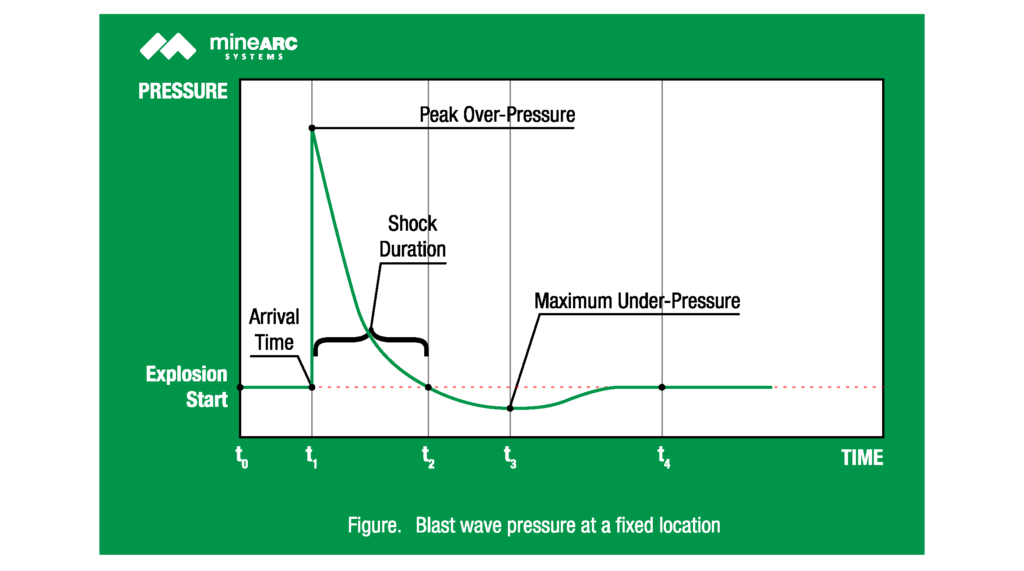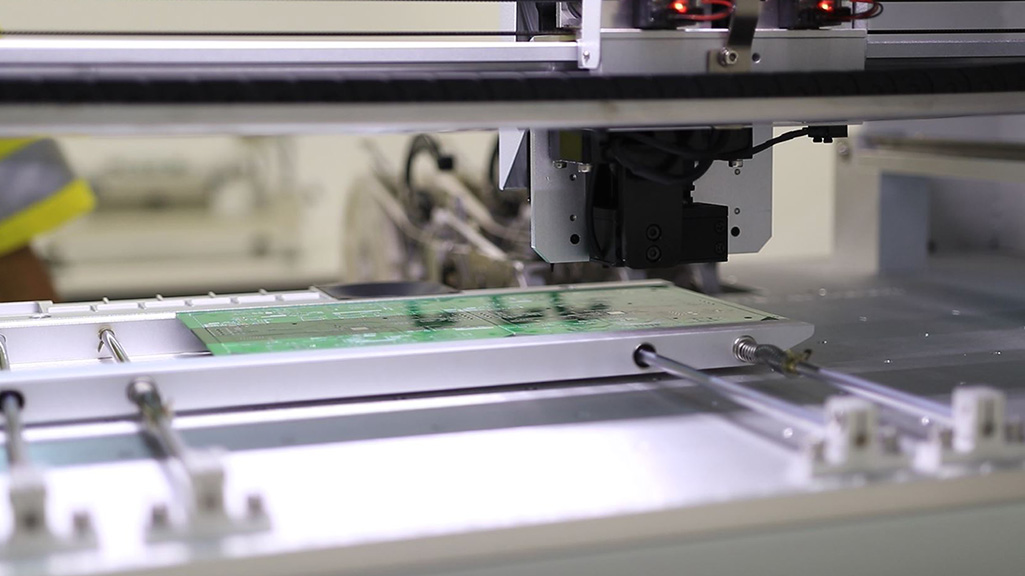Overpressure and Blasts
The most significant effect of an explosion is the sudden release of energy to the atmosphere, which results in a blast wave. The effect of a blast is generally measured in overpressure. Overpressure is the force on an object due to an impacting shock wave; it is a wave of energy released after the initial explosion.
A blast occurs when an initial ignition source’s reaction is proceeded by a shock wave in an outward movement from the primary point. A blast wave comprises the pressure front and subsequent wind, which occurs even after the combustible materials are consumed; this causes the most damage.
Blast overpressure travels faster than the speed of sound. The distance travelled depends on the type and size of the explosion. This blast wave continues to travel and cause damage long after the initial ignition is no longer visible.

Blast Wave Variation Over Time
In general, waveform consist of a peak in overpressure, positive pressure areas and negative pressure areas.
t0 – Explosion occurs
t1 – finite time the wave travels from the explosion to the affected location, e.g., office building. The pressure front hits the location at peak overpressure, immediately followed by consequent wind.
t2 – Pressure decreases to ambient pressure, but the wind continues in the same direction for a short time.
Most damage to free-standing structures occurs during the shock duration; between the blast wave hitting and the pressure drop.
t3 – Pressure continues to decrease, dropping below ambient pressure to a maximum under pressure. For most of the under-pressure period from t2 to t4, the blast wind reverses direction and flows toward the explosive origin.
t4 – Once maximum under-pressure is reached; the pressure continues to return to ambient pressure. By this time, blast winds and the direct destruction have ceased.
What overpressure can the ChemSAFE Chambers handle and is that figure relevant to the survival of its occupants?
The ChemSAFE Safe Haven and Refuge Chamber are built to withstand a 5psi, as a standard. However, these can be upgraded to a rating as high as 15psi or more based on client requirements.
A blast-rating upgrade may include a selection of the following:
- Additional 100mm x 50mm upright stiffeners
- Additional lateral stiffeners
- Fully enclosed rear housing for componentry protection
- Changes to material
- Changes to the external chamber profile
Understanding Blast Overpressure
Blast overpressure is caused by a wave of energy released after an explosion, including a pressure wave and supplementary wind. The bigger the explosion, the more significant and more damaging the blast overpressure.
Measuring Blast Overpressure
Overpressure is the pressure on an object due to the impacting shock wave.
Commonly used is Friedlander’s equation, which describes the rate of decrease in pressure values once the blast wave has fully developed. Friedlander’s equation assumes there are no nearby surfaces for the blast wave to reflect off.
An important consideration is how the pressure is measured as the blast wave passes. If the pressure transducer is at right angles to the blast wave, the over-pressure measured is known as the side-on over-pressure (free-field over-pressure).
Blast damage is based on the peak side-on over-pressure determination resulting from the pressure wave impacting a structure. The damage produced by various over-pressure conditions is given in the table.
Pressure
1 PSI = 6894.76 Pascals
5 Pound-force per square inch = 34473.8 Pascal
The formula for an approximate result, multiply the pressure value by 6895
What is PSI?
Pound-force per square inch (PSI) is a standard unit of measure of pressure/ stress, detailing the unit of pressure or stress. The pressure resulting from a force of one pound (453.6 grams) was applied to an area of one square inch (2.54 cm).
Pressure forces on a solid surface, from a liquid or gas, do not occur at a single point but spread equally along the whole surface. Because of this, the pressure was introduced to measure pressure forces independent of surface area size.
p = F / S
- Pressure (p)
- Force (F)
- Surface (S)
A pascal is a pressure of one newton per square metre (SI) or the SI base units, one kilogram per metre per second squared.
How much is 5psi?
5 psi equates to
| 5 PSI | +34 kPa | 0.34 Bar | 0.34 Standard Atmosphere | 258.6 Torr |
The Effect of Blast Overpressure on Buildings and the Body
The human body can survive a relatively high blast pressure; however, it is generally damage from the surrounding building and events which cause the most injury.
Blasts and explosions do not follow form, so it is challenging to offer a clear rule of thumb on damage and injury. However, testing on explosions and weapons can provide a general guide on the correlating damage and fatality rates at different peak overpressures, as shown in the below table.
Table 1 – Effect of various long-duration blast overpressures and the associated maximum wind speed on various structures and the human body.
Peak overpressure | Maximum wind speed | Effect on structures | Effect on the human body |
1 psi | 38 mph | Window glass shatters | Light injuries from fragments occur
|
2 psi | 70 mph | Moderate damage to houses (windows and doors blown out and severe damage to roofs)
| People injured by flying glass and debris |
3 psi | 102 mph | Residential structures collapse | Severe injuries are common; fatalities may occur
|
5 psi | 163 mph | Most buildings collapse | Injuries are universal; fatalities are widespread.
|
10 psi | 294 mph | Reinforced concrete buildings are severely damaged or demolished | Most people are killed
|
20 psi | 502 mph | Heavily built concrete buildings are severely damaged or demolished | Fatalities approach 100%
|
As shown in the table, buildings and structures receive more damage than the human regarding overpressure.
The behaviour of buildings and structures under blast or impact loading results in more extensive damage. In general, at 1 psi, a residential house would be deemed uninhabitable, 2 psi could destroy a building, and overpressures of 5 psi devastate cities.
While a person may withstand a higher psi, the body receives the most damage from subsequent conditions. The blast wind resulting from the blast overpressure have a significant impact. At these wind speeds, objects from within buildings, from structural damage or the surrounding environment can be thrown into persons. Alternatively, people themselves can be thrown into walls, hard surface, and across distances.
Safety Regulations for Explosions at Petrochemical Facilities
In high-risk areas, installing blast-resistant buildings (BRBs) or reinforcing existing buildings is recommended.
Currently, no government regulations exist for petrochemical facilities. However, recommended practice has been established by the American Petroleum Industry, namely API RP 752 and API RP 753.
These recommendations cover the use of permanent and portable blast rated buildings to protect occupants against potential hazards.
API 752, established in 1995, provides recommendations to petrochemical facilities regarding permanent, occupied buildings within the processing areas and the management of associated hazards.
API 753, established in 2007, provides recommendations to petrochemical facilities regarding temporary or portable occupied buildings within the processing areas and the management of associated hazards.






